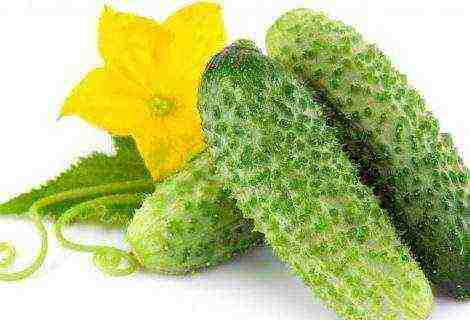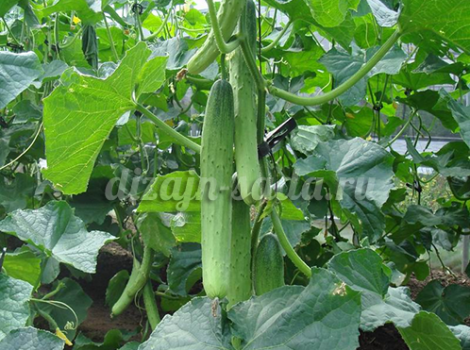Content [show]
What is a real climbing rose?
 This is when hundreds of thousands of beautiful flowers, collected in huge inflorescences, hang in armfuls from high supports like a kind of multicolored waterfall.
This is when hundreds of thousands of beautiful flowers, collected in huge inflorescences, hang in armfuls from high supports like a kind of multicolored waterfall.
It is worth a person to get into the Bagatelle Park, famous for its rose garden, in Paris during the period of mass flowering of ramblers - and this instantly changes his life. There comes a feeling that there was some kind of life before "Bagatel" and now a new one has come - after. And there is a dream to create something similar in your garden, so that the miracle is nearby.
Let's try to understand how this is possible in the harsh conditions of the middle zone and in the north-west of Russia. Let's take a look at the hardware first. There are two large groups of climbing roses - clammers and ramblers.
The first group contains varieties of roses, re-flowering, with rather rigid shoots, growing even in European countries to a height of 2 to 3 m.Most often they have rather large flowers, single or in small inflorescences - 3-5 pieces each, rarely more than 10 Among these roses are some old groups - remontant, bourbon, and climbing forms of hybrid tea and roses from the Cordes group.
Reference by topic: DIY rose garden
And although these roses are magnificent and in the more southern regions of Russia they can grow into wondrous tall luxurious bushes, roses of another large group - ramblers - are more suitable for the north-west of Russia and regions similar in climate.
These are roses of a completely different type - with very long shoots (3-4 m and more), easily amenable to tying to supports of any configuration. They form a fantastic number of flowers in incredible inflorescences - whole fountains of medium-sized flowers. They can be double or simple - this has almost no effect on the overall effect, they take not so much in shape as in number.
The peak of their popularity came at the end of the 19th - beginning of the 20th century. Most of the breeders of that era, succumbing to their witchcraft charm, took part in the creation of the tale. The appearance of ramblers radically changed the very appearance of gardens with roses, it became possible to move the riot and luxury into a vertical plane, to raise the pink splendor on various supports, to give them unusual shapes. As a result, fountains and fireworks of delightful flowers bloomed the skies in the gardens and allowed them to lift off the ground.
Oddly enough, many of those varieties that make up the glory and pride of old parks with climbing roses have not lost their importance to this day, and the best of them are still grown and multiplied by nurseries. What kind of varieties can be used for vertical landscaping of northern gardens?
See also: Rose flowers: a description of growing and caring for roses
The first favorite, which has not lost its importance to this day, is immortal Excelsa, one of the best vintage ramblers, capable of blooming on last year's shoots and does not require the preservation of older wood. It can grow up to 3-4 m, easily takes any shape and winters well under an air-dry shelter. Shoots are flexible enough and easily fit for the winter. It can pick up powdery mildew, but almost never gets sick with black spot. And MP can be easily cured by Topaz even with a single use.
 By the way, most old ramblers are sensitive to powdery mildew. And since this is not the most dangerous disease of roses, we can assume that this group of roses is one of the least problematic.
By the way, most old ramblers are sensitive to powdery mildew. And since this is not the most dangerous disease of roses, we can assume that this group of roses is one of the least problematic.
The next variety, which can be safely recommended even for a small area, is Goldfinch... The variety does not grow very gigantic, forming a very harmonious plant with lashes of 2.5-3 m. It has a creamy yellow tone, which is rare for ramblers, which becomes creamy as it blooms. Perfectly complements the pink-red, raspberry, lilac and violet colors, which are mainly characteristic of old ramblers. The variety is more resistant even to the curse of old scourge varieties - powdery mildew. And a truly invaluable quality of this variety, important for landscape practice, is the ability to bloom almost from the very base of last year's shoots, so when a huge surface does not need to be covered in a small garden, Goldfinch can be cut at any height, and there will still be abundant flowering.
Behaves a little differently Long John Silver... It does not bloom on last year's shoots, but on shoots of a higher order - 3 years and older, and this, of course, complicates the care and maintenance of this variety, as well as some other old ramblers. But the delightful perfection of large, almost pure white flowers makes you want to have this beautiful variety in your garden.
Another variety that I want to talk about is Bleu Magenta. It appeared on the flower market rather late - in 1933, when the finest hour of ramblers was already in the past, but its appearance revived interest in this class of roses due to its completely unique color. When blooming, the flowers are surprisingly velvety-violet-purple, and when blooming, they acquire a bluish-blue tint.
And in conclusion of the descriptions of once flowering climbing roses, I simply cannot fail to mention the divine Alchemist (AIchymist), who bred Rymer Cordes in 1956. The single flowering and shape of flowers were completely unfashionable in the year of its creation and decades after. Its popularity came later, when roses with an ancient flower shape came into fashion. The variety has a luxurious aroma, and the color is simply impossible to convey in one phrase, because it is constantly changing - first golden orange, then gradually saturated with pink and coral shades. Perhaps Cordes was right, calling him an alchemist - there is in him something of the magic that turned simple metal into gold. The variety is very winter-hardy and generally quite disease-resistant. But it cannot be said that it is very simple - it blooms for the first time, sometimes only in the 4th year, prickly and not very easy to care for. However, the magic that dwells in the garden where the Alchemist was planted will atone for all his little flaws!
Any of these roses are gorgeous, and there are dozens of others that can be successfully grown in northern gardens.
Reference by topic: Growing roses and caring for roses for beginners - Part 2
The best varieties of climbing roses
For our conditions, varieties with flexible shoots are SUITABLE, which can be bent and laid under a winter shelter.
Once blooming ramblera roses
- Alchymist
- American pillar
- Bleu Magenta
- Dorothy perkins
- Flammentanz
- Goldfinch
- Excelsa
- Long john silver
- Lykkefund
- Russeliana
Re-blooming climbing roses
- Dortmund
- Golden gate
- ilse Krohn Superior
- Jasmine
- Laguna
- Parade
- Quadra
- Sympathie
- Tea clipper
For our conditions, they are NOT SUITABLE with inflexible shoots that cannot be bent under a winter shelter.
- Aloha (Kordes)
- Penny lane
The most difficult operation to master if you decide to grow ramblers is winter shelter.
But in essence, it is no different from the shelter of any other groups of roses (not counting park roses). It is important that it is dry under the shelter and, if possible, there are no leaves on the stems.
Then overwintering is almost guaranteed and your efforts will be rewarded with the fairy tale that your garden will turn into for a month or more of their flowering. And with our short summer this is a lot, and hardly any other group of roses is capable of transforming your garden as much as once-blooming ramblers.
Below are other entries on the topic "Cottage and garden - do it yourself"
Roses of the Explorer series: Explorer - a series of roses: winter-hardy ... New varieties of roses (summer 2016) photo and description: Description and photos of new and ... How to plant roses correctly - a master class from a PROFESSIONAL: RIGHT PLANTING OF ROSES What can be ... Canadian park roses - varieties , care and cultivation in a flower garden: For those flower growers who believe ... Frost-resistant roses - I share my growing experience: HOW I GROWED FROST-RESISTANT ROSES Two ... Plum varieties for the Far East: Plum varieties for Primorye Primorsky Krai ... Early carrots in the Urals - planting and recommended varieties: Fresh carrots in June? Easy! Garden ...
Subscribe to updates in our groups.
Let's be friends!
The rose is the unchanging queen of any garden. Almost every gardener breeds, or at least tries to breed such beauty on his site. But, as you know, the rose is capricious and is not given to everyone. This was the case until recently. Now the family of this flower is multifaceted, it differs in species and varieties in terms of size, height, configurations, colors, shapes and shades of the flower itself, as well as characteristics of resistance to weather conditions. Consider one of the significant groups of this flower - Rambler climbing roses, go over the varieties with photos and descriptions.
Climbing roses-ramblers: varieties, photos and description
Rambler are the so-called real climbing roses, which are used to decorate facades, architectural forms, and decorate gazebos and paradise gardens. With the help of roses of this group, you can successfully hide the flaws of any buildings, or decorate them with them in such a way that it will be impossible to look away.
And all this is due to the fact that the climbing rose consists of flexible thin branches, the growth of which can reach up to 6 meters! And their property to curl is very useful when decorating - a rose easily wraps around any arches, trellises, fences, etc. In this regard, they are sometimes called curly. As already clear, this group of roses cannot grow without any support.
Rambler have a dense green foliage color, and small rose flowers are collected in large double beautiful inflorescences. This group is distinguished by excessive flowering, but, unfortunately, almost all varieties have a single flowering. Flowers appear only on last year's shoots. This period of color celebration lasts about 1.5 weeks.
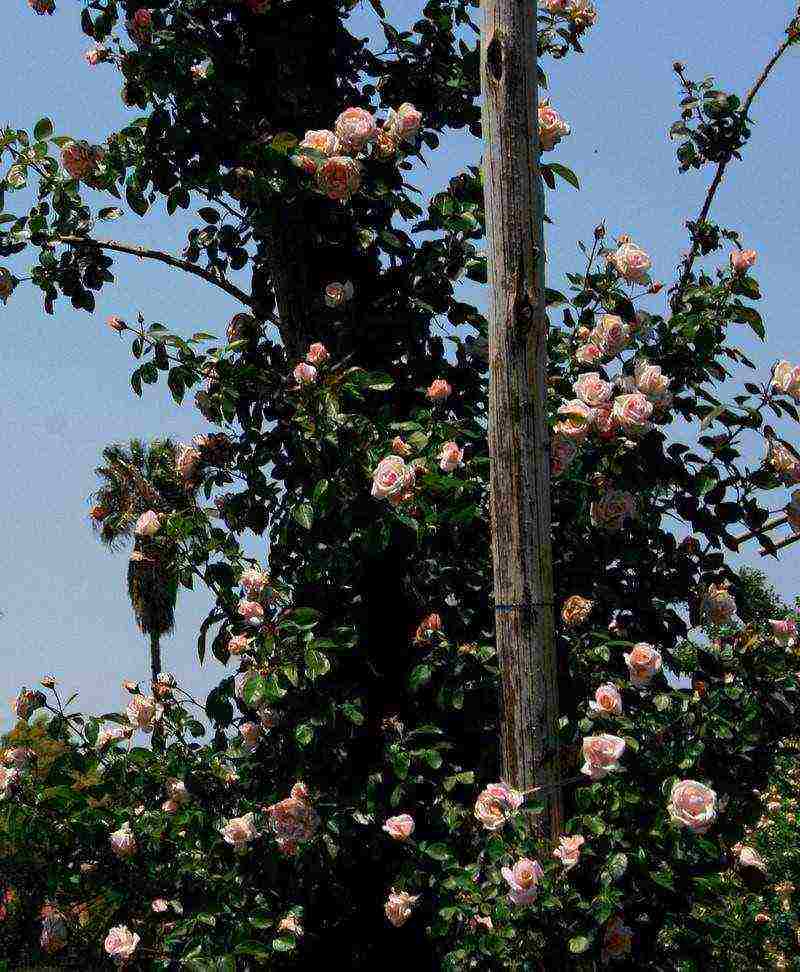
Rumbler roses: care
Features of planting varieties of this group, of course, exist. This is, for example, the distance between the bushes - it should be observed in such a way that the lashes of the rose can freely fit on the ground (for wintering). Rumblers prefer loamy soil, but, of course, fertility is indispensable here, so we recommend adding ripe manure or compost to the soil. You should also pay attention to humidity - roses cannot stand water stagnation in the soil. Planting seedlings is best done in the spring, before bud break.
In general, ramblers are quite disease-resistant plants, but there are exceptions here. A disease that all varieties of this group are susceptible to is powdery mildew. And therefore, preventive measures in the form of spraying should be carried out, and flowers should also be monitored often in order to prevent the development of the disease. Caring for a rose also includes pruning - branches shading the bush and shoots remaining after a single flowering should be removed in a timely manner.
Rumbler roses must be prepared for winter without fail. This means that the lashes must be laid on the ground and covered with material (spruce branches, agrofibre).
Consider some varieties of Rambler.
Rose Red Rambler (Red Parfum, 1972)
This park variety got its name because of its color - the rose has flowers of a bright, intense, fiery red color. The flowers themselves are not very wavy, not very double, but rather large - an average of 8 cm in diameter. The flowering of this variety is solitary, roses are never collected in the brush. But it blooms again, and more and more abundantly the next time. The aroma of Red Rambler is present, but moderate.
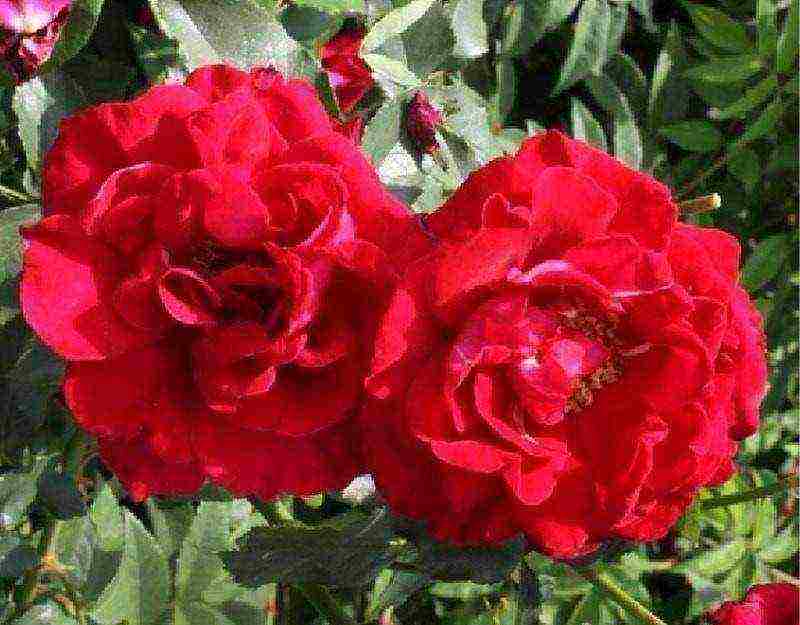
Scourge varieties with dark green foliage, which perfectly sets off the flowers themselves, are low, reaching only half a meter in length. The width of the bush is about 80 cm on average. It wraps around arched structures most successfully.
Rose Red Rambler is resistant to various diseases and has increased frost resistance. This variety does not need to be pinched. Very responsive to feeding.
Rose Crimson Rambler (1894)
This type of rambler is characterized by intensive growth and, as a result, fast surface coverage, for example, the wall of a house. Prefers southern sides, but copes successfully with light partial shade. The height of the rose is on average 4 m.
Crimson flowers are small - they do not even reach 5 cm in diameter, but they are grouped into an inflorescence in the amount of 40-50 pieces, so the inflorescence turns out to be downright impressive! The color of the roses is fiery carmine red, on a green background it looks just amazing when it starts to bloom. Flowering at Crimson Rambler is one-time and lasts just over a month. Despite the external beauty, this rose has no scent at all.
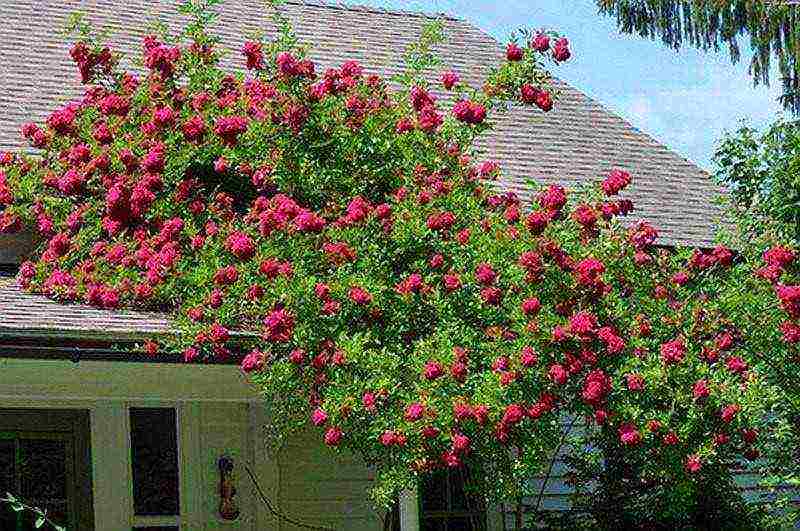
As for the conditions of detention, firstly, this is the soil - light, neutral, retaining moisture. Well, as already mentioned, an abundance of sun is desirable. In principle, Crimson is quite resistant to difficult weather conditions. For the winter, like all ramblers, they cover, in this state, it is able to survive in frosts reaching 30 degrees, which makes the rose available for cultivation in many areas.
Albrighton Rambler (Ausmobile), 2013
This fairly new variety of rambler has a pale pink, airy hue, more often more creamy. The flower itself is bowl-shaped, rosette, the petals are arranged in a circle, in waves, along the edges there are large petals, then their size decreases, in the center - like a button. Diameter - 5 cm. Flowers on the lash are located not in inflorescences, but one by one. Such a flower lives on average for 3 days, but if you take a branch in general, then its flowering lasts about 2 weeks. The flowering itself is continuous, lasting from June to September. By the way, one of the few varieties in the group of ramblers that blooms again!
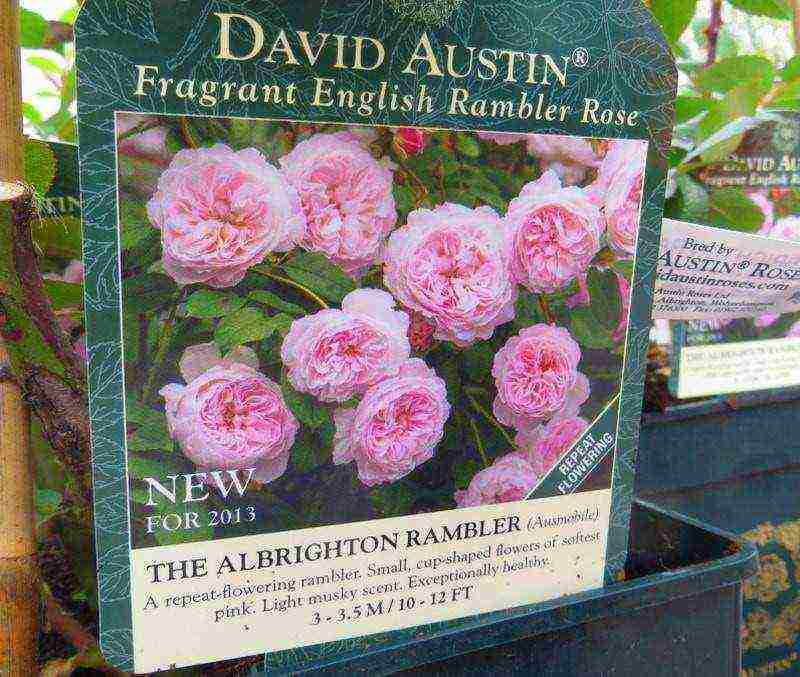
It reaches a height of 3-3.5 m, in the first year it can gain 1.5 m. The rose liana itself bends well, has a moderate number of thorns. Albrighton also has a slight scent - barely noticeable, musky.
It should be noted that with proper care, this rose almost never gets sick. A huge plus is the fact that Albrighton flowers are not afraid of rains, that is, they do not fall after them, but in their original form they are kept on a branch.
Mannington Mauve Rambler (2001)
This rose variety has a rich lilac (purple) color of flowers, which fade into light lilac over time and closer to autumn. Small double flowers (3 cm in diameter, no more) are collected in inflorescences, which are strewn with the entire branch.
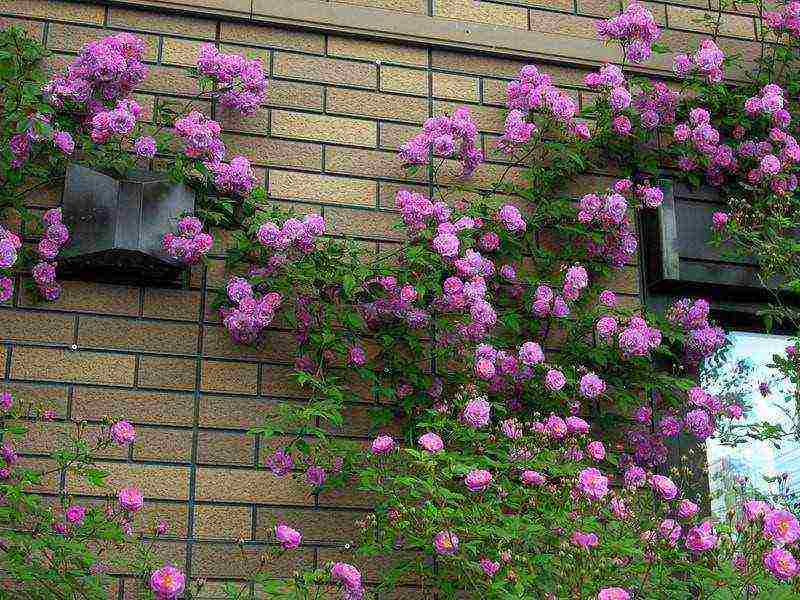
Manninkton's foliage is usually green in color, has a rather matte bloom. Plus - the shoots are almost without thorns. Unfortunately, it blooms once, during flowering it smells, and not much, but not subtle.
This is perhaps one of the tallest plants in the rambler group - it can reach 6 meters in height, which makes it possible to use it to decorate rather tall architectural forms. But the width of the bush is not large, it is no more than 30 cm. Manninkton Mov is unpretentious to the sun - it grows well both under its rays and in the shade.
Lemon Rambler (2015)
This is a very recently bred variety, about which little is known, since the entire period of its life has not yet been fully tested.
The Lemon Rambler bush stretches up to 3 meters in height, the bush can reach more than a meter in width. Flowers, as in general, the name implies, have a white color with a light, airy, slightly yellowish tint, smoothly turning to the middle into a light yellow color, which becomes more saturated, lemon in the center of the rose.
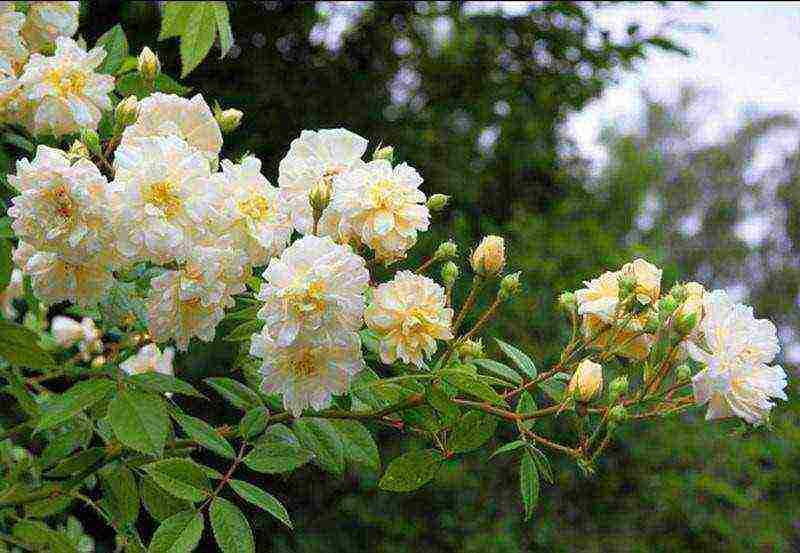
This variety has continuous flowering: as soon as one part fades, the other begins to bloom. The aroma is more pronounced than that of all other ramblers.
Average frost resistance.
Uetersen Rambler (Rosarium uetersen, 1977)
This rose is more of a wide bush than tall lashes. Utersen Rambler is a large-flowered climbing rose, its rather voluminous double flowers resembling ruffles (the diameter of which can reach as much as 12 cm), have a wide range of colors - they can be either bright crimson or deep pink.
Flowers on a branch can appear either one at a time or gather in inflorescences. The leaves of the flower are dense. So to speak, the "style" of this rose is in the category of vintage, and therefore it was not popular for a long time. Utersen blooms in early summer, and gradually, over the course of the season, its petals begin to slowly, one at a time, fall off. The very first flowering is very abundant; later on, the rose produces a smaller number of loose flowers. And besides, it can skip seasons and not bloom at all.
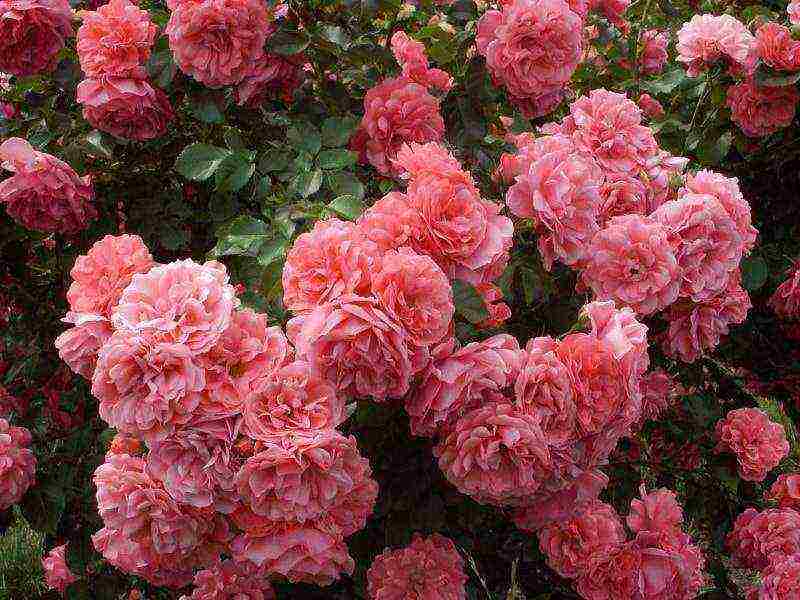
As for resistance, this is the most unpretentious of all varieties of this group. Despite its romantic appearance, it is resistant to rain, wind, and cold snaps. It also has good frost resistance.
An open, sunny place, which will be moderately blown by winds, is suitable for landing Utersen Rambler. Naturally, the south side of the world should be chosen. It quickly builds up shoots, and responds very well to pruning, so this procedure can be carried out safely.
Goldfinch Rambler (Goldfinch, 1903)
This variety of climbing ramblers is one of the oldest, besides, it is the first rose with bright yellow flowers, which, unfortunately, quickly fade to cream shades.
Semi-double flowers are collected on a brush in an amount of 15 to 25 pieces. It is noteworthy that this rose blooms from the very base of the shoots, which is why the variety is recommended for small gardens. Even if the rose is cut, the bloom will still be abundant from top to bottom.
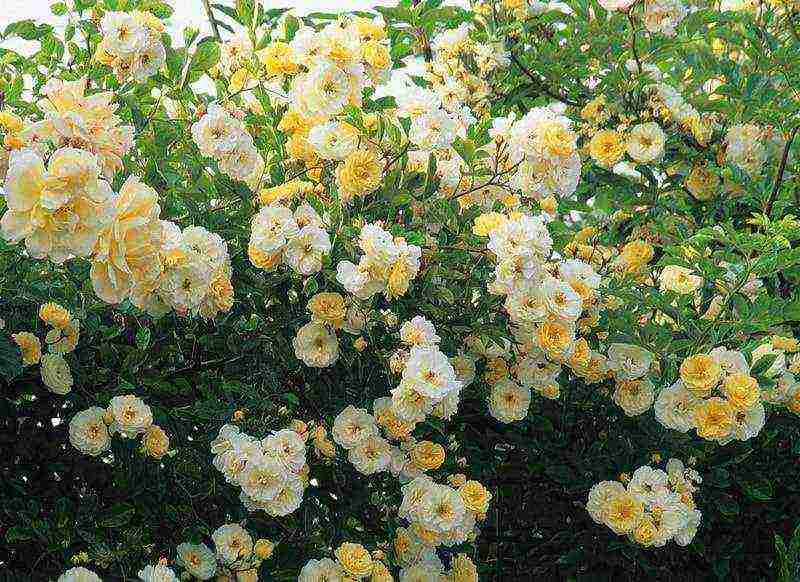
The foliage is small, emerald green. The height of Goldfinch is no more than 3 meters, the whips are flexible, but strong, with a small number of thorns. Due to its "compactness" it can be grown not only as a climbing rose, but also as a wide bush.
Goldfinch Rambler is resistant to powdery mildew diseases, winters well, and is not capricious in care.
Climbing roses of the rambler group look great in gardens decorated in the English style. And the selection does not stand still, the assortment is becoming wider, and as you can see, many varieties of rambler roses have been bred that are worthy of your attention.
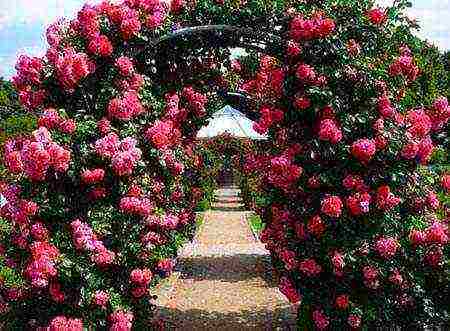 Climbing roses will not leave anyone indifferent.
Climbing roses will not leave anyone indifferent.
Shoots creeping upwards beautifully frame arches, gazebos, trellises, creating a cozy picturesque corner.
And blooming, fragrant flowers evoke delight of emotion and attract attention.
Look at the gorgeous climbing roses in the photo, but their names are ear for our people, since the selection was mainly carried out by foreign experts.
Climbing rose, varieties, photos and names
This type of roses is divided into two types: Rambler and Climbers (Climbers). If the first are the heirs of small-plaited roses (several small roses are collected in a large inflorescence), then Climbers (Climbers) are large-flowered representatives, which are also more capricious and non-frost-resistant.
Since most gardeners, when choosing a particular plant, are also guided by the color scale, the plant varieties are further presented by color.
Rumblera roses - varieties and photos
Rambler are more suitable for cultivation in our climate, since their flexible stems can be bent and laid under shelters for the winter.
Varieties with roses of red tones
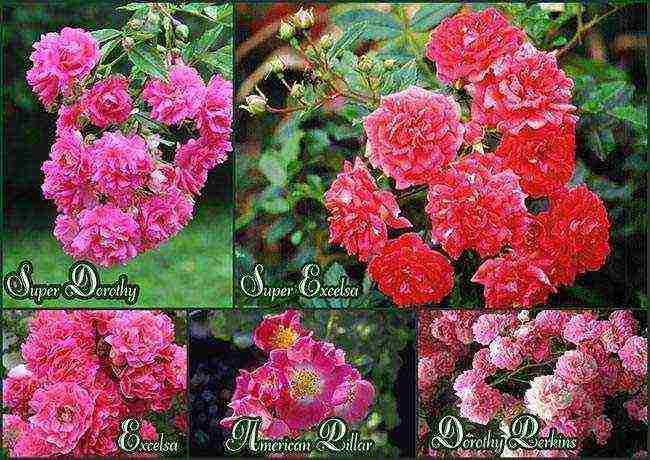
· Excelsa - on green foliage, which retains its decorative effect until autumn, semi-double flowers of a red-crimson color appear within a month. The plant can grow in partial shade and on poor soils, is winter-hardy, but blooms once.
· Super Excelsa - an improved version of the previous variety. Terry roses of bright crimson color appear throughout the summer. It is inferior to its predecessor in stature, grows well in hot climates.
· Dorothy Perkins - similar to the profusely flowering Excelsa, but unlike it has double pink flowers. It is susceptible to powdery mildew, frost-hardy.
Super Dorothy - An improved version of Dorothy Perkins. The flowers are deep pink with a white spot in the center. It is less susceptible to diseases such as powdery mildew. Refers to late flowering plants, but flowers bloom until frost.
· American Pillar - a richly blooming rose that blooms late. One of the most frost-resistant roses, it is also easy to care for and easily propagated by cuttings. It blooms with carmine-pink flowers, which have a white center and bright yellow stamens. The rose is resistant to partial shade and disease.
Varieties with yellow flowers

· Goldfinch - the first yellow rambler. But unfortunately, the bright yellow color in the sun fades very quickly and the flowers turn white. May be affected by powdery mildew and black spot, although this is not reflected in flowering. Suitable for growing on the north side.
· Ghislaine de Feligonde is a multi-flowering plant with apricot-colored flowers. But the color can change - the flowers fade to peach, white or pink. Long and abundant flowering. The cultivar can be affected by powdery mildew.
· Emily Gray - a variety with yellow-cream flowers and a light aroma. They planted it in open sunny places. Hardy plant, disease resistant.
Easlea’s Golden Rambler is a variety with golden yellow double flowers that thin out the strong aroma. Heat- and frost-resistant plant, has immunity to diseases.
· Scarman’s Golden Rambler is a re-flowering variety. Creamy yellow flowers with a faint pleasant smell bloom from large crimson buds.
Varieties with white flowers
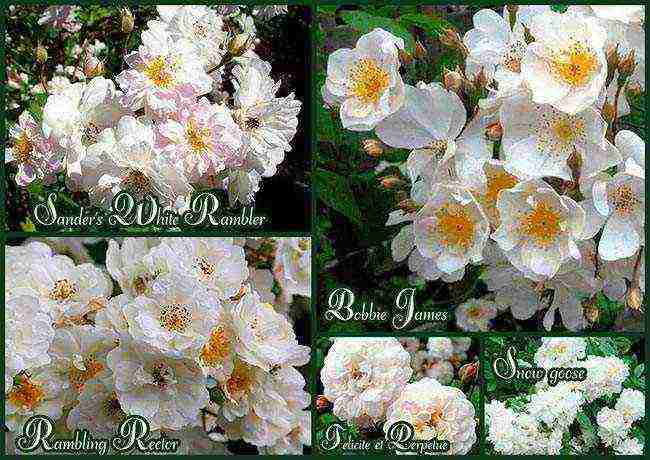
· Felicite et Perpetue - an old hybrid, originally from France. Creamy white flowers with a pale pink tinge of 20-40 pieces are collected in large inflorescences, but blooms once. This plant is shade-tolerant, immune to disease, frost-resistant. If you are just new to growing climbing roses, then they are for you.
· Snow goose is a re-flowering rambler. The flowers are creamy white, but fade very quickly in the sun to a pure white color. They have petals of different lengths, so they resemble daisies. Suitable for growing in hot climates where it blooms almost continuously.
· Sander’s White Rambler - blooms with individual white double flowers. The flowers are not afraid of rain and have a strong scent. Can grow in partial shade and on poor soils. The variety is resistant to diseases.
· Bobbie James is a vigorous variety that requires a lot of space. In early summer, it is covered with numerous white flowers with yellow stamens, reminiscent of cherry blossoms. After flowering, small red-orange fruits are formed.
· Rambling Rector - a rose with creamy white small flowers that turn snow-white in the sun. Each flower is decorated with yellow stamens, but over time they turn brown.
Climber roses - varieties and photos
Climbers are distinguished by rigid, thick, erect stems that do not need support, but create certain difficulties for sheltering them for the winter.
Varieties with red flowers
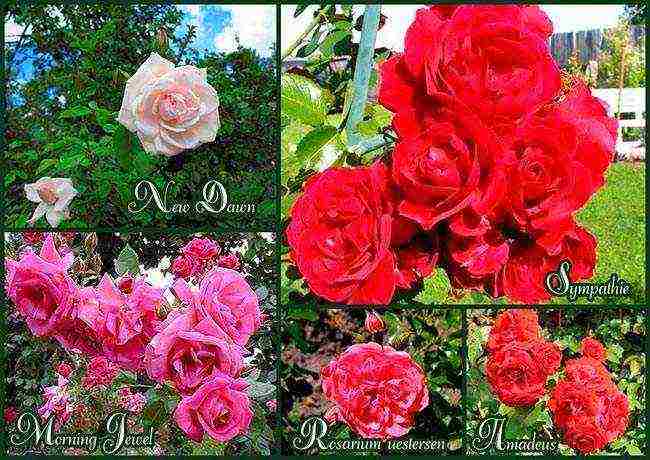
· New Dawn is one of the popular varieties. It is often sold as a curly rambler, but this is wrong. The rose blooms with single, pearl-pink large flowers. In the sun, they fade and become white with a pink tint.The plant can withstand light partial shade and poor soils.
Rosarium uestersen is a multi-flowering variety. The plant has bright pink double flowers that are resistant to rain and wind. This winter-hardy plant is resistant to black spot and powdery mildew.
· Amadeus is a climbing rose with large bright red flowers emitting a light aroma. Abundant and repeated flowering. The plant is resistant to various diseases, flowers do not fade in the sun and do not lose their decorative effect. They tolerate frost well down to -25 C °.
· Sympathie is another hardy and re-blooming cultivar with gorgeous bright red flowers and raspberry tints that withstand wind and rain very well. The plant is resistant to diseases.
Morning Jewel is a variety with rich pink flowers and a small white center. The flowers are resistant to unfavorable weather - wind, rain and hot sun. They do not lose their color under the rays of the sun. It grows well both in sunny open places and in partial shade. But with improper care or unfavorable conditions, it can be affected by powdery mildew.
Varieties with yellow flowers
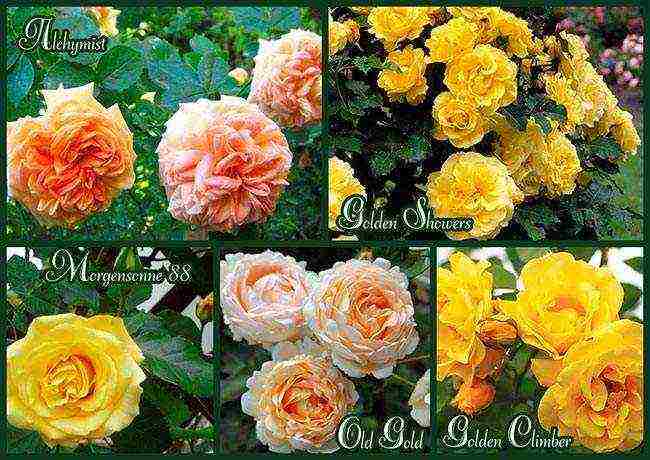
· Golden Showers - early flowering variety with bright yellow flowers. In the hot sun, they become lemon or cream in color. It is most suitable for mild climates and has medium resistance to major diseases.
· Morgensonne 88 is a variety with rich yellow flowers that quickly fade in the sun to a creamy shade and a pleasant aroma. It is resistant to diseases, but under unfavorable conditions it can still be affected by them.
· Alchymist - the variety is unique for its color, in which there really is magic. Under certain weather conditions, golden yellow roses bloom on the bush. But usually the outer petals have this color, the inner ones are painted pink. Over time, the color fades to a delicate apricot or honey shade. The plant is susceptible to black spot disease.
· Golden Climber - single flowering variety. Large semi-double flowers of golden-yellow color and a very strong "tasty" aroma bloom on the bush. The plant is disease resistant, winter hardy and can grow in poor soils.
· Old Gold - continuous flowering rose with strong aroma. The flowers are creamy with a bright apricot-yellow center. After flowering, fruits are formed. It can be grown in partial shade.
Varieties with white roses

· Alaska - a variety with light cream-colored double flowers. The rose is resistant to black spot and powdery mildew. It blooms again, flowers have a weak aroma.
· White New Dawn - the flowers resemble a gardenia flower. They are white with bright yellow stamens in the middle. The re-flowering variety is susceptible to black spot.
· Elfe - the rose pleases with flowering all summer. Densely double flowers of greenish-white color thin out a mild fruity aroma. The plant is immune to disease, but the buds may not open in the rain.
· Schneewalzer - a rose with large flowers, reaching 13-15 cm. When blooming, the petals have a pale lemon color, but over time they become pure white. In rainy weather, the buds may not open.
· Schwanensee is a multi-flowering variety with white roses, in the center with a pale pink tint. Flowers have a faint scent. The plant is not resistant to black spot, therefore it requires regular prevention.
For your attention an article on the rules of planting, care and cultivation of climbing roses.
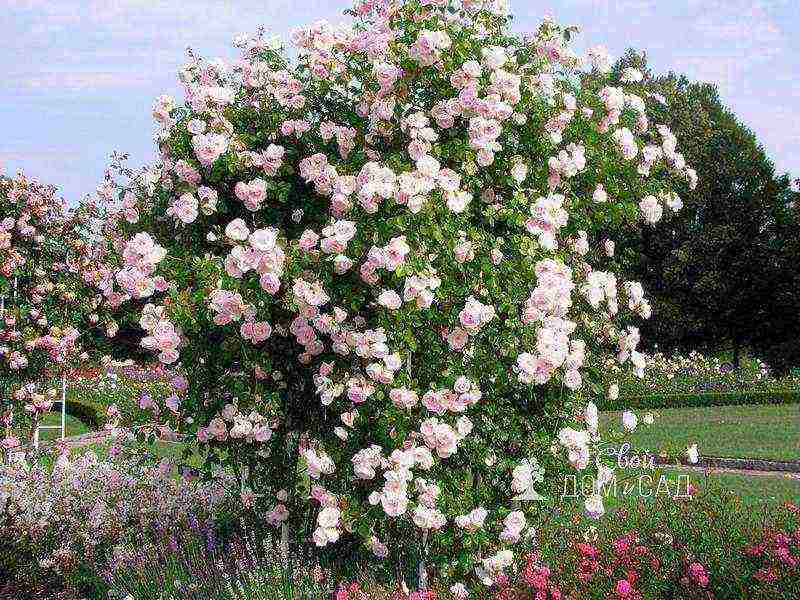 Climbing roses are one of the most beautiful plants in any garden and are often used by designers for vertical landscaping. They are incredibly beautifully combined with small architectural forms, decorative columns, and are suitable for decorating arches and other architectural structures. With the help of climbing climbing roses, you can decorate the house and garden buildings, create a hedge.
Climbing roses are one of the most beautiful plants in any garden and are often used by designers for vertical landscaping. They are incredibly beautifully combined with small architectural forms, decorative columns, and are suitable for decorating arches and other architectural structures. With the help of climbing climbing roses, you can decorate the house and garden buildings, create a hedge.
Description and photos of the best varieties of climbing roses
Climbing roses do not belong to climbing plants or vines, because they do not have antennae and suckers. To grow up, they need support - vertical structure.
Climbing roses are divided into two large groups: small-flowered Rambler and large-flowered Climbers.
The division of climbing roses is based on the fact that ramblers bloom on the shoots of previous years, and climings - on the shoots of the current year.
Rambler - features, varieties
- Climbing roses ramblera (Rambler) are small-flowered roses, most often they are hybrids of the rose Wichuriana (Vishuriana) or Multiflora (Multiflora). Quite winter-hardy, they winter well under a light dry shelter.
- Rambler have small flowers from 2 to 3.5 cm in diameter on thin, flexible, creeping shoots from 2 to 15 meters long.
- Depending on the variety, flowers can be double, semi-double, simple with a variety of colors and smells.
- Blooming of ramblers begins in the first half of summer. The rose blooms once, but very abundantly and lasting 30-35 days.
- Rosa Rambler has a two-year cycle of shoot development. In the first year, zero shoots grow and there are no flowers; in the second year, lateral flowering shoots grow.
In the third year, they are usually not left, because they practically do not bloom anymore. Every year, on the lower part of last year's shoots and from the ground, new young shoots grow, which are important to preserve and cover well for the winter. These shoots will bloom accordingly next year. Such is the development cycle of the climbing rose Rambler.
Common varieties of climbing roses Rambler
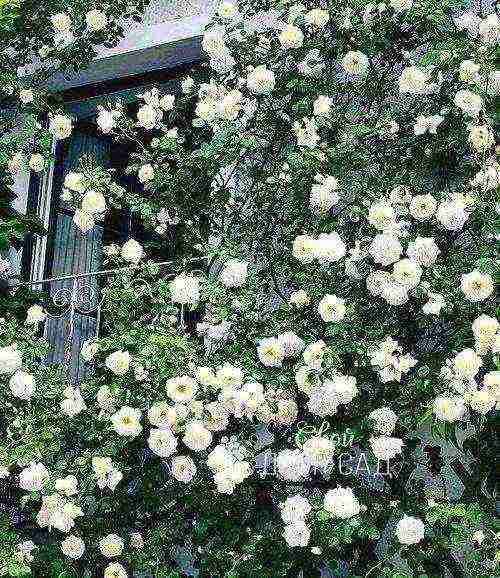
Climbing rose rambler Alberic Barbier

Climbing rose Bobbie James (Bobby James)
- Alberic barbier - is the ancestor of climbing roses. This ancient rose was bred in 1900 in France, and its parents were Shirley Hibbard and Rosa wichuraiana. But even now, 100 years later, it remains a hit among climbing roses.
The flowers are white, small, double, weakly fragrant. The stems of a rose reach 5 meters in length, therefore, space and a bright area are needed for normal development. In regions with cold climates, this variety needs shelter and protection from the spring winds. - Bobbie James introduced in the UK in 1961 - a hybrid Multiflora. It is one of the most luxurious and abundant small-flowered white ramblers. Flowers with a strong characteristic aroma, creamy white, semi-double in large racemose inflorescences. A very vigorous rose that requires room for normal development and growth. Stems 5-8 m long or more. Winter hardy, suitable for cold climates.
- Felicite perpetue bred in France in 1828, the Sempervirens hybrid is the most famous of the hybrids. Flowers are pale pink, large, densely double, in brushes of 20-40 pieces. The bushes of this rose are strong, vigorous, with a height of 3 to 5 meters, requiring space for growing. The rose is unpretentious in care, frost-resistant, perfect for beginner growers.
- Dorothy perkins - introduced to the USA in 1901. The flowers are pink, double, with a weakly fragrant aroma. It blooms once for 30-35 days. Hardy, shade-tolerant, susceptible to powdery mildew.
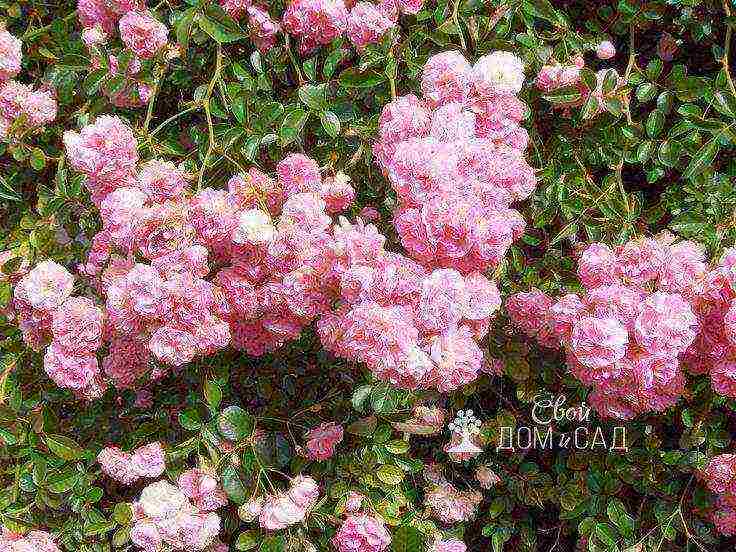
Climbing rose Dorothy Perkins
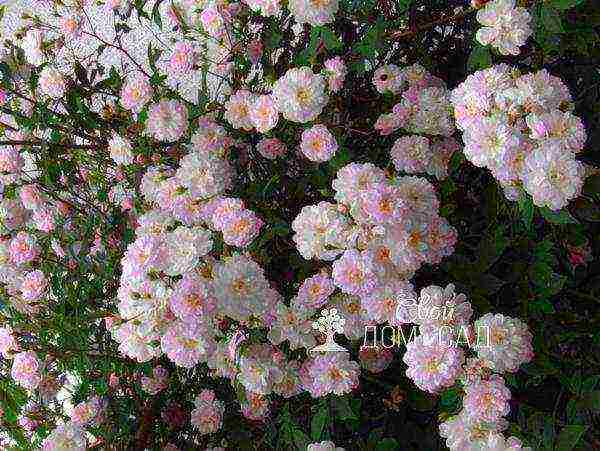
Climbing rose Felicite Perpetue
The following varieties are very popular:
• Whites: Snow Goose, Mountain Snow, White Dorothy Perkins, Ernst Dechant, White Flight
• Pink: Bonny, Dentelle de Malines, Wartburg, Lyon Rambler
• Red: Crimson Shower, Alexander Girault
• Lilac: Veilchenblau, Bleu Magenta
• Yellow: Goldfinch

Climbing rose Snow Goose
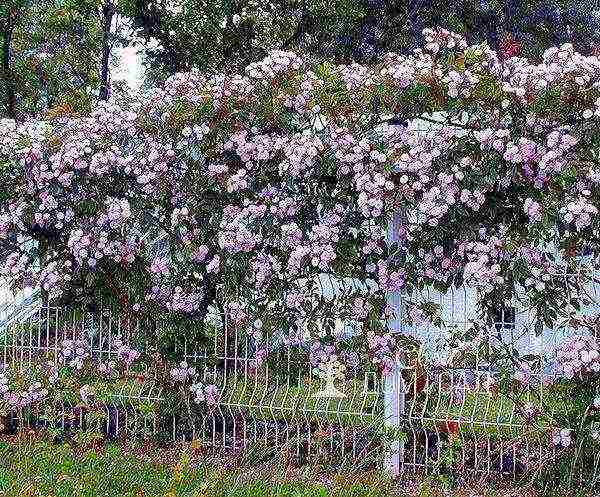
Rose Dentelle de Malines
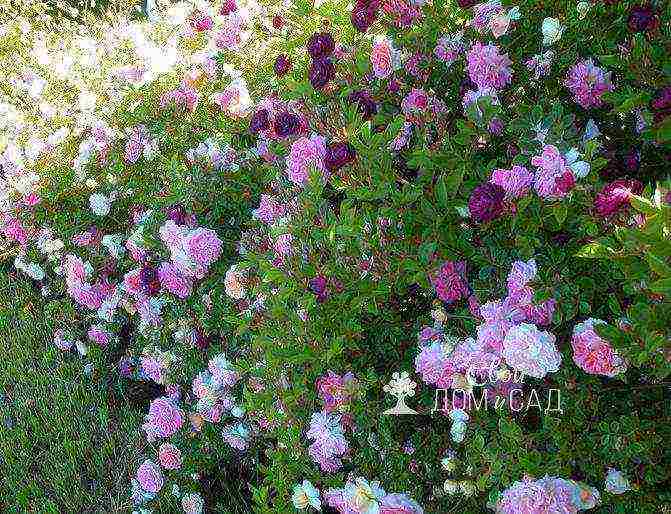
Climbing rose Bleu Magenta
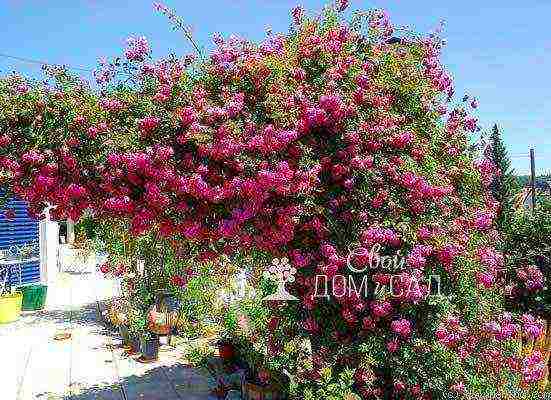
Rose Alexander Girault
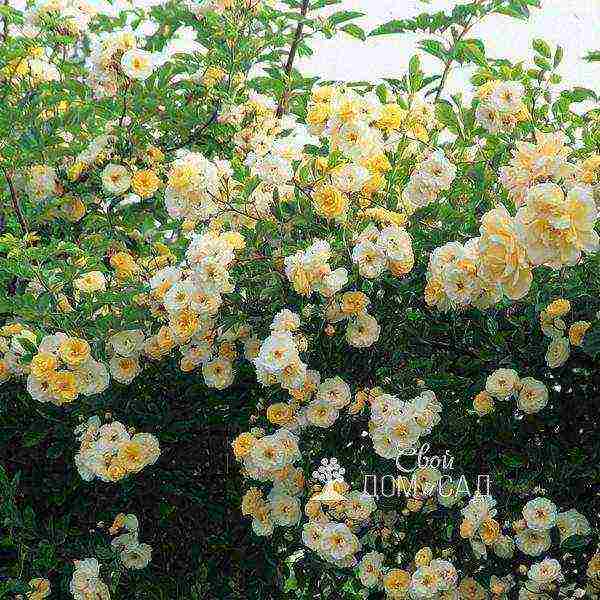
Climbing rose yellow Goldfinch
Large-flowered climbing roses
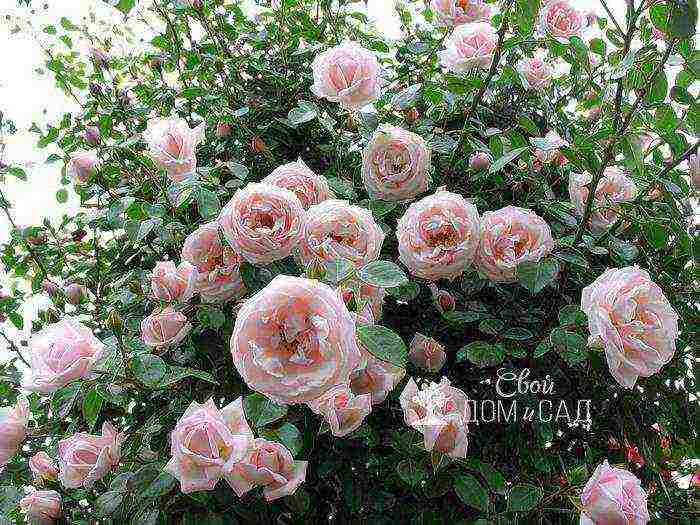
Large-flowered rose New Dawn
They were bred as a result of crosses of various varieties. This type of climbing roses is distinguished by strong growth, large flowers and long shoots - up to 5 meters. Flowers are similar in shape to hybrid tea. These roses bloom once, but for a very long time - almost all summer.
Unlike small-flowered roses, these roses have rather tough and thick, whip-like shoots. It can be grown without supports on erect stems, flowers are formed on both perennial and young shoots. Sufficiently resistant, frost-resistant.
A typical representative of curly large-flowered roses - variety New Dawn.
Roses Climing
Translated from English "climbing" means climbing, climbing. This group includes hybrid tea roses, floribunda, grandiflora.They are distinguished by strong growth, large single or small inflorescences with flowers and later fruiting.
The plant forms strong whip-like shoots, on which flowering occurs the following year. These shoots must be preserved during the winter.
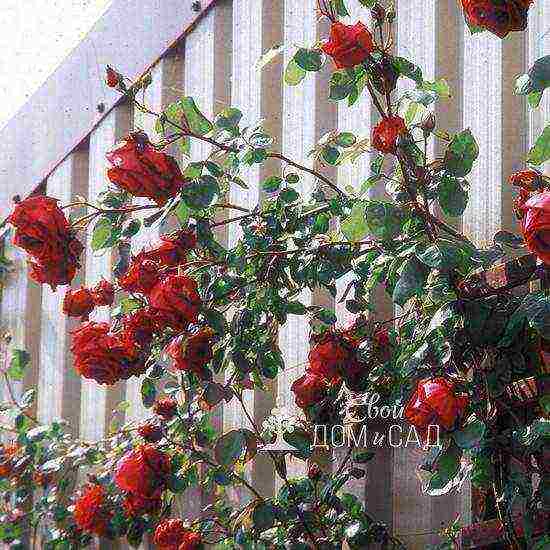
Climbing rose Ena Harkness
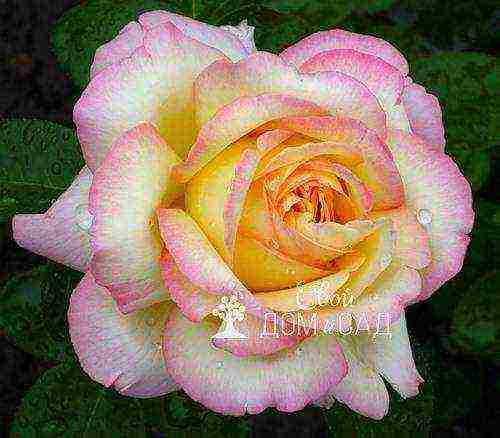
Gloria Dei / Peace
Ena Harkness variety (climbing teahouse), bred in 1954. A mutation of a hybrid tea rose with very decorative crimson-red flowers and a pleasant scent. The buds are large, fragrant, appear on drooping, thin shoots, almost or not at all fade. In a sunny place, the variety blooms at the end of May and blooms all summer.
The most widespread variety among climings was the Gloria Dei (Peace) hybrid tea rose.
Popular varieties of large-flowered climbing roses:
- New dawn Is a Wichurana hybrid. Semi-double fragrant pink flowers with a pleasant aroma. Abundant flowering all summer and autumn. Needs a garter, height from 2 to 5 meters (if supported). Very hardy, disease resistant.
- Schwanensee bred in 1968 in Ireland. It has thick and strong erect shoots up to 2-3 m. Flowers are white with a pink tint in the center. The shape of the flowers is classical, the flowers are large, double. Differs in abundant flowering throughout the summer and autumn. Prone to black spot.
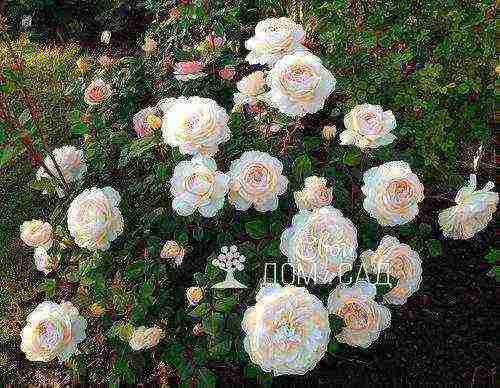
Climbing rose Schwanensee
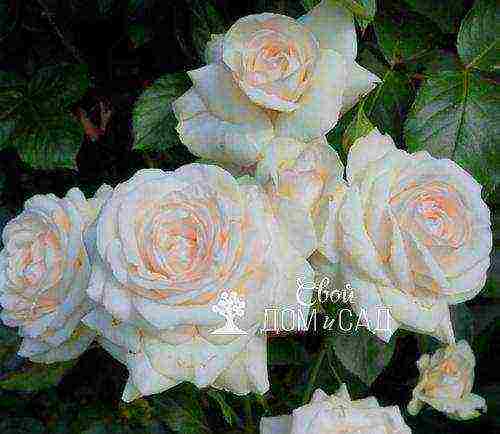
Climbing rose Schwanensee
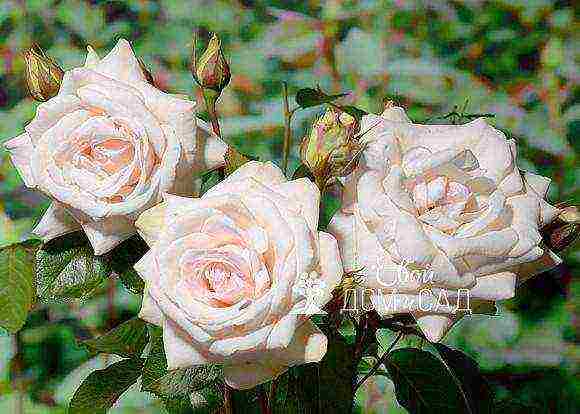
Climbing rose Schwanensee
- Breath of life - a very popular climbing rose with single double apricot flowers. The rose rarely grows more than two meters in height, it is afraid of a humid climate, but it is very beautiful.
- Compassion - hybrid tea rose with large double flowers of orange hue. Strong shoots, up to 3 meters long. It is one of the most favorite climbing roses among gardeners.
- Golden Showers bred in the USA in 1956 - climbing rose variety. Blooms profusely before frost. The flowers are bright yellow, lemon-colored, large, fragrant, double. With occasional pruning of the shoots, the rose can be grown as a large scrub. Golden is sensitive to cold and thrives in the south.
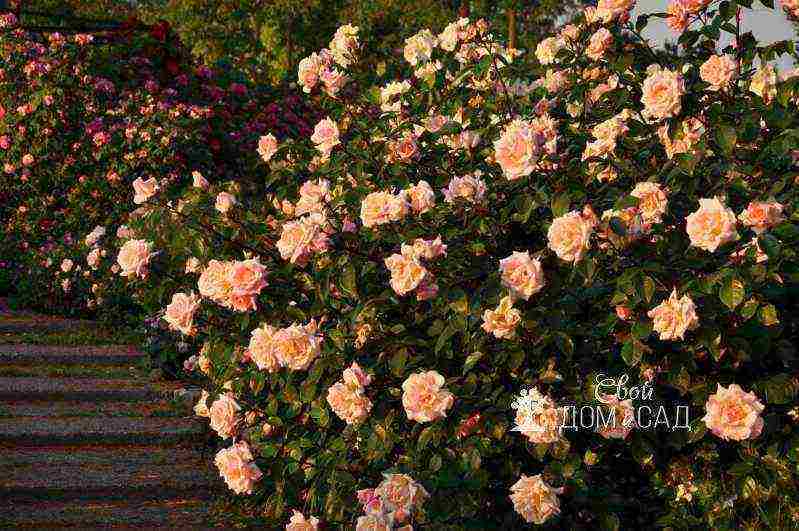
Climbing roses kompeshn
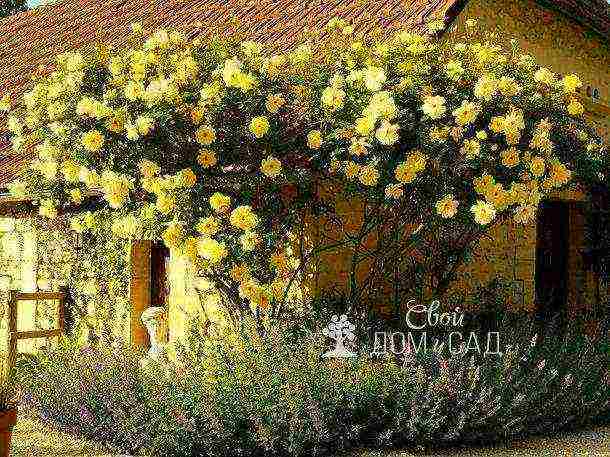
Climbing roses Golden-Showers
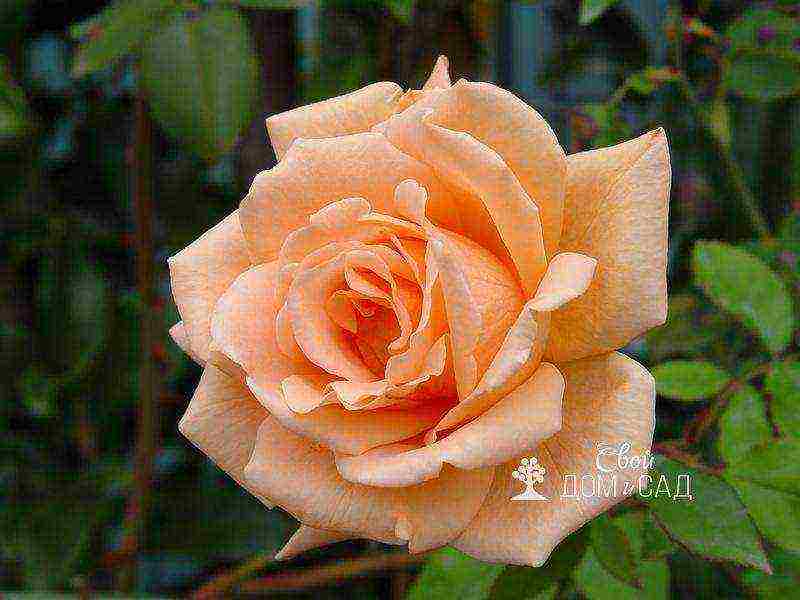
Breath-of-Life braided rose
Roses of Cordes (Kordersii)
This type of rose is a combination of a hybrid of wrinkled rose and Vishurana rose. Obtained on the basis of the Max Graf variety. Differs in abundant flowering until late autumn and excellent frost resistance. In addition, the variety is quite resistant to diseases and pests.
Roses of Cordes have large flowers, single or collected in inflorescences of 3-10 pieces. The foliage is bright green, shiny.
The following varieties are distinguished from the roses of Cordes:
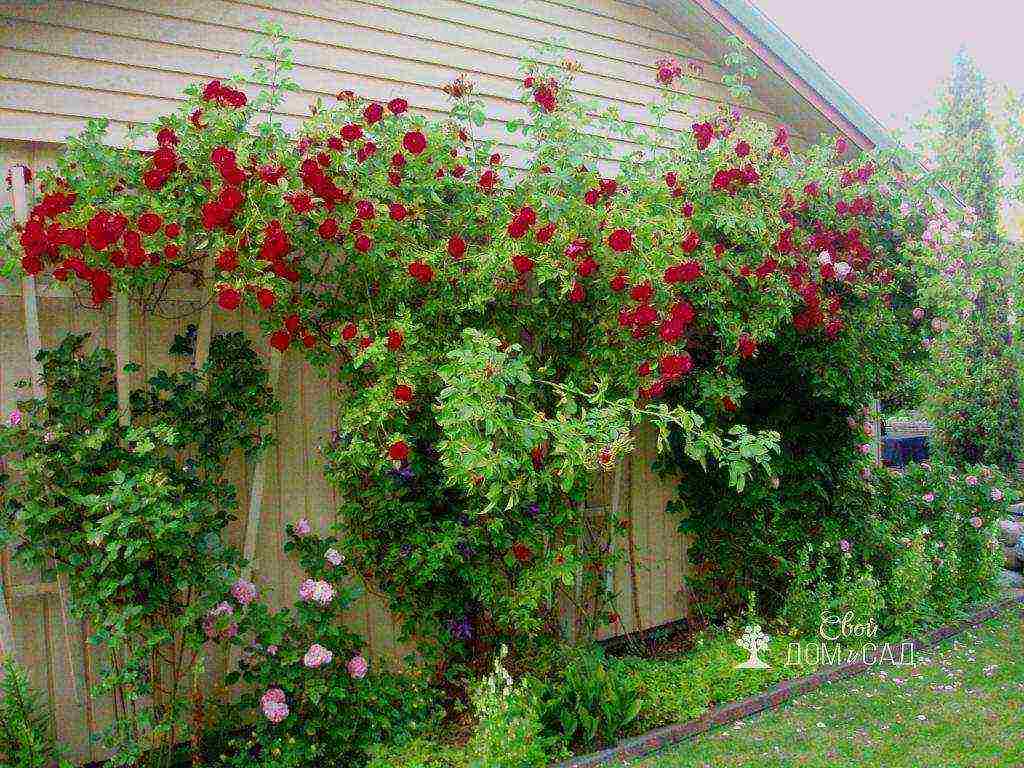
Rose Flammentanz

Rose Flammentanz
- Flammentanzhybrid Rubiginosa - beautiful climbing roses. Sprawling, densely flowering bush 2.5-3 meters high with bright green leaves. By the nature of growth and flowering, it is closer to ramblers. Bright red large flowers with a slightly fragrant aroma. It blooms once within 30-35 days. Hardy, disease and pest resistant.
- Simpathy hybrid Kordesii - bright red flowers with a velvet-crimson tint, slightly fragrant, in brushes of 3-10 pieces. Repeated flowering, branched bush, reaching a height of 4 meters. Bright green leaves. It tolerates cool climates well and is resistant to diseases.
- Ilse Krohn Superior hybrid Kordesii - White, large, fragrant flowers. Blooms repeatedly in small brushes of 3 pcs. Suitable for cold climates, disease resistant.
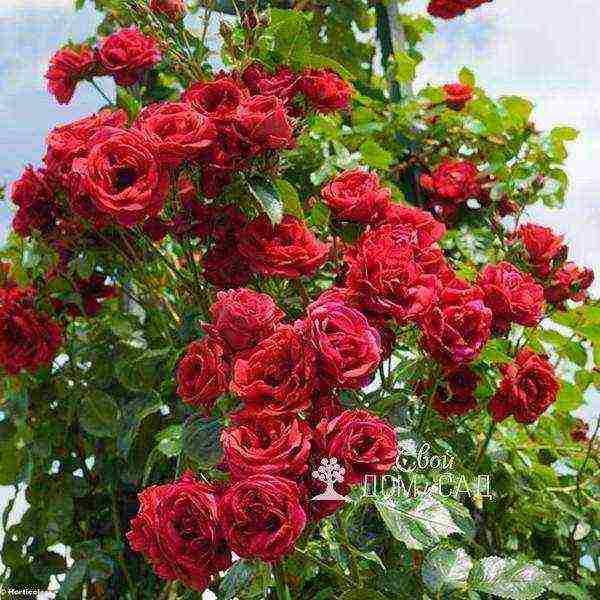
Climbing Roses Simpathy Sympathy
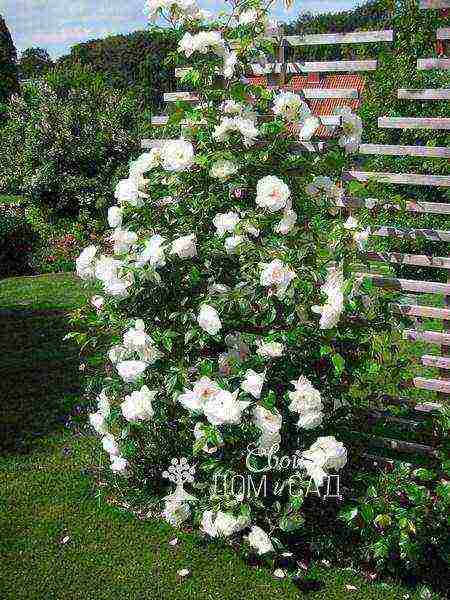
Climbing roses Ilse Krohn Superior (Ilse Kron Superior)
Climbing miniature roses
 This group has become popular only in recent years, it is fundamentally no different from the previous one. The lashes of these roses reach 1-2 meters, like those of their individual counterparts, the size of the leaves and flowers is noticeably smaller, that is, the same as those of ordinary miniature roses. Miniature roses are mainly obtained through hybridization.
This group has become popular only in recent years, it is fundamentally no different from the previous one. The lashes of these roses reach 1-2 meters, like those of their individual counterparts, the size of the leaves and flowers is noticeably smaller, that is, the same as those of ordinary miniature roses. Miniature roses are mainly obtained through hybridization.
Of the varieties of this group, it is worth noting:
- Hi-Ho - carmine pink
- Nice Day - salmon pink
- Warm Welcome - bright orange-scarlet
